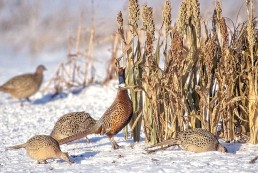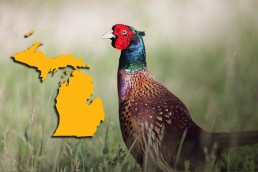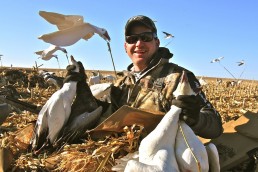Chasing Rooster Pheasants in the Snow
SHARE THIS POST
Hunting pheasants right after a fresh snowfall has always been one of my favorite things. I look forward to those types of hunts more than any other. There’s something special about walking over glistening fields in search of big rooster pheasants. I was especially excited because my dog Sunny would be the lead bird finder for me, and she has a great track record. Sunny is my golden retriever that just loves to get out in the fields and hunt pheasants. Over the years she has refined her skills and is a national champion bird dog that has won many awards for her tracking abilities.
The morning of the hunt came and we were both up early to hit the fields. Upon looking out the window, I noticed that it had snowed during the night. After a nice drive, we arrived at our hunting location. It’s almost as if Sunny knew we were there because it showed in her excitement. The fresh snow she and I saw was like a fine powder on the ground and sparkled as if someone had sprinkled diamonds all over.
After loading my shotgun, I gave Sunny her first command and we were off on the hunt.
When pheasant hunting in the snow, there are a few things you can do to help increase your odds of landing birds. If you are hunting with a dog, try to keep him or her in a closer range to you than you normally would. On open ground, it’s good to let your dog roam farther ahead of you so that it will get onto scents more frequently. However, when hunting in light to medium snow cover you want your dog to stay closer to you so that you have a tighter control on what the dog is doing.
Keep in mind that when there is snow cover, pheasants will hunker down tight into the brush and not move and you may walk right past them. You want to keep your bird dog closer so it will naturally work in more of a zigzag pattern. This will increase your chances of flushing those tight-holding birds.
Are you enjoying this post?
You can be among the first to get the latest info on where to go, what to use and how to use it!
When hunting in snow, don’t always rely on your dog to make a flush. You should walk in a zigzag, uneven pattern so you can cover any ground the dog may have missed. You would be surprised at how many birds get flushed by the hunter and not the trained dog. Remember that in the cold weather the dog’s ability to catch a good scent can be hindered by the weather. Scents do not travel as well in colder weather and denser air, so the dogs will often have to be closer to a holding bird before they pick up a scent.
Over the years in the snow-covered fields or ground, another trick I’ve found is to stagger the type of shotgun ammunition you use. By doing so you will have all ranges covered for a clean, humane kill shot. Load your shotgun with a first- and second- shot load of good number 6 shot. This will be for that fairly close to intermediate shot when the bird flushes and starts to fly away. For your third shot, load a quality number 4 shot. This will be better for that longer shot you may have to make if you miss with the 6 shot. Hopefully you will not need the 4, but you never know. Again, we are looking for a humane kill shot and this combination has proven to provide just that.
If you are working with a partner, do not spread out to far from each other. This way you will cover any birds that you may otherwise not find if you were spread too far apart. Also, each one of you must know your own shooting area really well for safety. Know what area is yours to cover if a bird flushes, and do not fire at a bird that is not in your designated area of fire. Going against this rule can be very dangerous.
Pheasant hunting over some fresh snow cover can provide some of the best experiences in bird shooting. Follow some simple rules and adjust to any changes and you will surely enjoy the hunt.
MWO
SHARE THIS POST
Did you enjoy this post?
You can be among the first to get the latest info on where to go, what to use and how to use it!
Mike Cyze
Mike Cyze has been called one of the most knowledgeable multispecies river anglers in the country. His ability to catch fish under the challenging conditions encountered in the river environment, combined with his overall fishing knowledge, has earned him recognition as a true Mississippi River Expert. Contact him at: lastcast13@yahoo.com.



